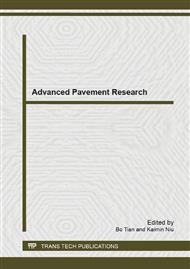[1]
Hiller, J. and J. Roesler, Determination of Critical Concrete Pavement Fatigue Damage Locations Using Influence Lines. Journal of Transportation Engineering, (2005). 131(8): pp.599-607.
DOI: 10.1061/(asce)0733-947x(2005)131:8(599)
Google Scholar
[2]
Miller, J.S. and W.Y. Bellinger, Distress Identification Manual for the Long-Term Pavement Performance Program. 2003, Office of Infrastructure Research and Developement, Federal Highway Administration: McLean, VA, USA.
Google Scholar
[3]
Roesler, J.R., V.G. Cervantes, and A.N. Amirkhanian, Accelerated performance testing of concrete pavement with short slabs. International Journal of Pavement Engineering, (2011). 13(6): pp.494-507.
DOI: 10.1080/10298436.2011.575134
Google Scholar
[4]
Heath, A.C., J.R. Roesler, and J.T. Harvey, Modeling Longitudinal, Corner and Transverse Cracking in Jointed Concrete Pavements. International Journal of Pavement Engineering, (2003). 4(1): pp.51-58.
DOI: 10.1080/102984303100016073393
Google Scholar
[5]
Ann Myers, L., R. Roque, and B. Birgisson, Propagation Mechanisms for Surface-Initiated Longitudinal Wheelpath Cracks. Transportation Research Record: Journal of the Transportation Research Board, (2001). 1778(-1): pp.113-122.
DOI: 10.3141/1778-14
Google Scholar
[6]
Chen, D. and M. Won, Field Investigations of Cracking on Concrete Pavements. Journal of Performance of Constructed Facilities, (2007). 21(6): pp.450-458.
DOI: 10.1061/(asce)0887-3828(2007)21:6(450)
Google Scholar
[7]
Yao, J. and Q. Weng, Causes of Longitudinal Cracks on Newly Rehabilitated Jointed Concrete Pavements. Journal of Performance of Constructed Facilities, (2011). 26(1): pp.84-94.
DOI: 10.1061/(asce)cf.1943-5509.0000212
Google Scholar
[8]
Mahoney, J., et al., Urban Interstate Poratland Cement Concrete Pavement Rehabilitation Alternatives for Washington State. 1991, University of Washington: Seattle, Washington 98105.
Google Scholar
[9]
Bayrak, M.B. and H. Ceylan, Neural Network-Based Approach for Analysis of Rigid Pavement System Using Deflection Data. Transportation Research Record: Journal of the Transportation Research Board, (2008). 2608(-1): pp.61-70.
DOI: 10.3141/2068-07
Google Scholar
[10]
Darter, M.I., Design of Zero-Maintenance Plain Jointed Concrete Pavment, Vol. I-Development of Design Procedures. 1977, Department of Civil Engineering, University of Illinois at Urbaba-Champaign Urbana, Illinois, U.S. A.
Google Scholar
[11]
Selezneva, O., D. Zollinger, and M. Darter. Mechanistic Analysis of Factors Leading to Punchout Development for Improved CRC Pavement Design Procedure. in Seventh Insternational Conference on Concrete Pavements. (2001). Orlanddo, Florida, USA.
Google Scholar
[12]
Selezneva, O., et al., Development of a Mechanistic-Empirical Structural Design Procedure for Continuously Reinforced Concrete Pavements. Transportation Research Record: Journal of the Transportation Research Board, (2004). 1896(-1): pp.46-56.
DOI: 10.3141/1896-05
Google Scholar
[13]
Rao, C., et al. Effets of Temperature and Moisture on the Responson of Jointed Concrete Pavements. in 7th International Conference on Concrete Pavements. (2001). Orlando, Florida, USA.
Google Scholar
[14]
Choubane, B. and M. Tia, Analysis and Verification of Thermal-Gradient Effects on Concrete Pavement. Journal of Transportation Engineering-Asce, (1995). 121(1): pp.75-81.
DOI: 10.1061/(asce)0733-947x(1995)121:1(75)
Google Scholar
[15]
Hansen, W., et al., Effects of paving conditions on built-in curling and pavement performance. International Journal of Pavement Engineering, (2006). 7(4): pp.291-296.
DOI: 10.1080/10298430600798952
Google Scholar
[16]
Qin, Y., Numerical Study on the Curling and Warping of Hardened Rigid Pavment Slabs, in Department of Civil and Environmental Engineering. 2011, Michigan Technological University: Ann Arbor, MI.
Google Scholar
[17]
Schindler, A.K., Concrete hydration, temperature development, and setting at early-ages. 2002, The University of Texas at Austin: Ann Arbor. pp.531-531 p.
Google Scholar
[18]
Mohamed, A. and W. Hansen, Effect of Nonlinear Temperature Gradient on Curling Stress in Concrete Pavements. Transportation Research Record: Journal of the Transportation Research Board, (1997). 1568(-1): pp.65-71.
DOI: 10.3141/1568-08
Google Scholar
[19]
Armaghani, J.M., T.J. Larsen, and L.L. Smith, Temperature Response of Concrete Pavements. Transportation Research Record, (1987). 1121: pp.23-33.
Google Scholar


